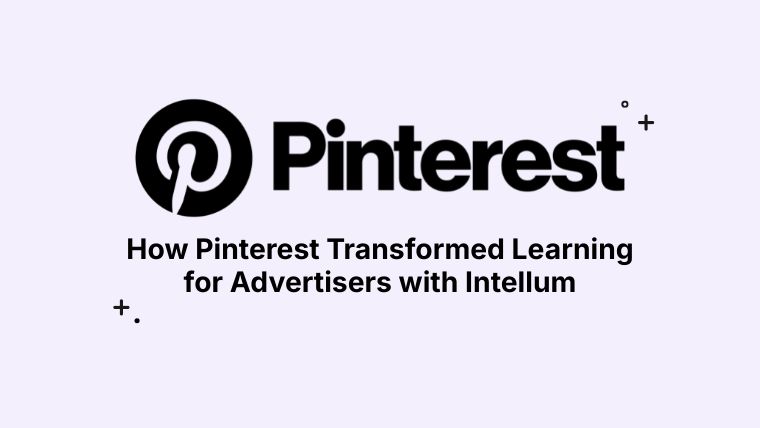Starting a partner training program is one of the most underused levers for driving Education-Led Growth. While most companies prioritize employee or customer education, new research shows that training partners can directly impact revenue, retention, and performance.
Well-trained partners have the skills needed to sell your product, close new business, and retain customers.
A partner network is a lot like an investment fund. The more you put into it, the bigger rewards you reap.
Most enterprise companies—like Google, Meta, and IBM—have robust partner learning initiatives in place. That said, startups and scale-ups can (and should) educate their partner network, too.

IBM's partner training program is called IBM Partner Plus™
So, how do you build a scalable partner training program?
A mistake many companies make is building an education program from scratch. Without a blueprint to guide you, you might skip essential steps that ensure your eLearning content drives the desired behavior change. (It’s not enough to learn information; partners must also apply their new knowledge.)
To start a successful partner training program at your organization, let’s look at the seven pillars of Education-Led Growth (ELG):
- Business goals
- Audience strategy
- Resources
- Content strategy
- Delivery strategy
- Marketing strategy
- Measurement
- Application
This strategic foundation enables you to build a curriculum-based, formalized, and scalable partner training initiative that aligns to go-to-market goals and delivers measurable impact
As you can see from the graphic below, certain types of training initiatives drive better business outcomes.

There’s a Partner Training Gap
According to a 2022 Intellum survey of 500+ education leaders, only 25% of businesses educate partners. The same study revealed that companies are three times more likely to educate customers and employees than partners. This striking disparity highlights the persistent “Partner Training Gap.”

There are several known benefits of training partners, including:
- Improved customer retention
- Improved partner success
- Decreased support costs
- Increased revenue
So, then, why is this happening? Why are companies neglecting their partners?
First, while most every company has employees and customers, fewer companies have partners (channel partners, partner resellers, etc.). So it’s natural that partner education has the lowest adoption rate.
Another reason companies don’t invest in training materials for partners? They assume partner education requires a separate initiative, dedicated resources, and a full content team.
This narrow view leads many to overestimate the effort required, when in reality, education can be scaled across audiences. Rather than thinking holistically, they compartmentalize—and when resources are tight, they prioritize customers and employees instead.
This perfect storm of mistaken beliefs plus resource constraints creates the partner training gap. If not addressed, this gap can hinder your potential.

Why You Must Train and Enable Your Partners
Scalable education is a cornerstone of Education-Led Growth. Programs that serve multiple audiences and offer multiple initiatives—like onboarding, enablement, and certification—report significantly higher revenue effectiveness (2025 State of Education-Led Growth Report).
In the context of corporate training, “scalable” means the ability to support additional learners with minimal administrative effort.
Some education professionals don’t realize they can repurpose content for different audiences. But you absolutely can.
For example, customers, partners, and employees all need better product onboarding and education tied to a user maturity model. You might use the same video product training video within your customer, partner, and employee training programs.
If you use a learning management system (LMS) built to educate multiple audiences, you can share content between customers, employees, and partners. This ability to repurpose training materials and build personalized learning paths helps you create a scalable education initiative.

Companies with scalable education initiatives are most likely to experience improved partner success, according to the same report mentioned above.

Starting a scalable partner training program with the Education-Led Growth Framework
Below you’ll find details on each of the eight focus areas within our methodology. You don’t have to complete one step to move on to the next; they can happen in tandem. You must execute all eight successfully.
1. Business goals
Partners have a lot to learn.
At a basic level, your partners must understand the product and how to sell it. Of course, you must offer product education and sales training. But that only scratches the surface.
For example, if you’re trying to create a market category, you need to teach them about your category. If your partners will deliver workshops to clients, you might offer public speaking training.
Conduct a training needs analysis to determine “gaps” between the current state (what they know) and the desired state (what you need them to know and do). Once needs are clear, then you can create education goals that tie to the overarching business goals.
2. Audience strategy
Audience strategy is about defining your audience segments and learner personas. Only then can you make smart decisions about content and delivery methods.
Audience segments
Not every partner is alike. You can choose to segment your audience by tier (e.g., legacy partners, new partners), by niche (e.g., manufacturing, finance), or some other way.
Learner personas
Within each audience segment, you can group learners who share common characteristics. This could include training goals, job responsibilities, or skill level.
3. Resources
Building a partner education team doesn’t have to mean a large internal department. The most important role on your team is the program owner or strategic lead, who aligns the education initiative to business goals.
For everything else, many companies successfully rely on a mix of vendors, freelancers, and internal contributors. In fact, according to a 2024 study conducted by Forrester, high-performing organizations are far more likely to use vendors for strategic support, not just speed.
AI can also play a major role by helping teams generate content, adapt training to different audiences, and even deliver interactive learning experiences. When paired with a strategy to repurpose content across learners, this blended model makes partner enablement much more scalable and sustainable.
4. Content strategy
There are different types of content within an organization. Education content is built to drive behavior change. (Or at least it should if designed and executed well.)

Building a learning content strategy allows you to gain alignment on:
- Substance: What content to develop
- Structure: How content will be delivered across channels
- Resourcing: What you can create, given available skills, budget, and time
- Governance: Who’s in charge of ongoing content creation and quality
5. Delivery strategy
This is where you map delivery to the learner journey. For example, as part of your onboarding process, you might have multiple assets: a virtual training session, videos, and help articles. When building your partner training delivery strategy, you’ll answer:
- How do partners navigate these?
- How does each asset connect to the others?
- Does content need to be consumed in a certain order?
- When do you point a person toward one versus the other?
If you have several types of partners with different learning needs, answer these questions for each learner persona.
A key component of your partner enablement strategy will be application. How do you assess a partner’s ability to communicate your messaging and positioning, products and services? This is where a tool like Yoodli’s AI roleplays might come into play. AI roleplays let partners practice objection handling, product positioning, or compliance scenarios in a safe, scalable environment—without needing to add more headcount to your partner team.
6. Marketing strategy
There are four elements of marketing strategy:
- Go-to-market strategy: What is the value proposition for each audience segment? Which channels will you use to promote your education initiative?
- Launch plan: How do partners navigate the learning platform? Where can they go to find support? How can they find content tailored to their specific needs?
- Awareness building: How can education help learners reach their long-term goals?
- Engagement tactics: How will you continue to engage learners over time?
7. Measurement
You need to know if your program is successful. One helpful measurement model is the Kirkpatrick Model, which measures learner proficiency across four levels: reaction, learning, behavior, and result.

(Discover questions you can ask learners and metrics to measure at each level here.)
8. Continuous Improvement
Continuous improvement is the process of learning from data, iterating on your program, and republishing content. You’re not always best served by creating more content. Often, your channel partner training program goes further by improving and refining your existing content. This focus on continuous improvement allows your team to focus on what matters most, instead of endlessly creating new content and materials.
Ready to Empower Your Partners?
Partner training is no longer a nice-to-have—it's a growth driver. With the right strategy, tools, and content, you can deliver scalable, high-impact education that helps partners sell more, stay engaged, and drive better outcomes for your business. Whether you're just getting started or ready to level up your existing program, adopting the Education-Led Growth framework gives you the blueprint to scale with confidence.



.png)

